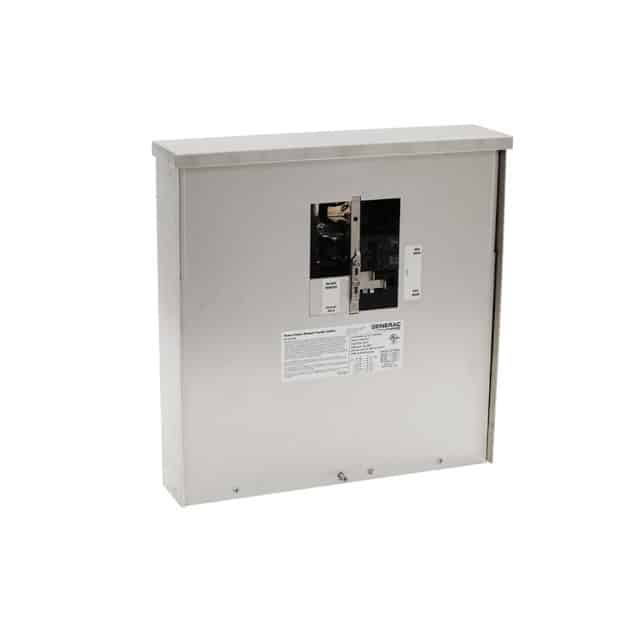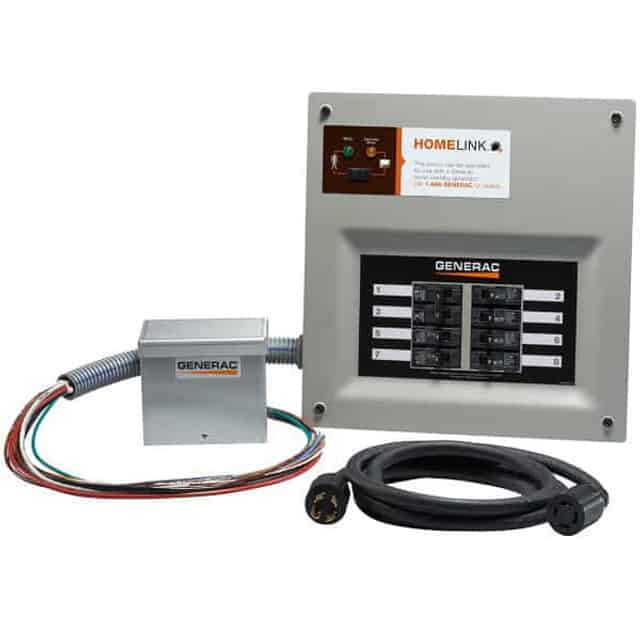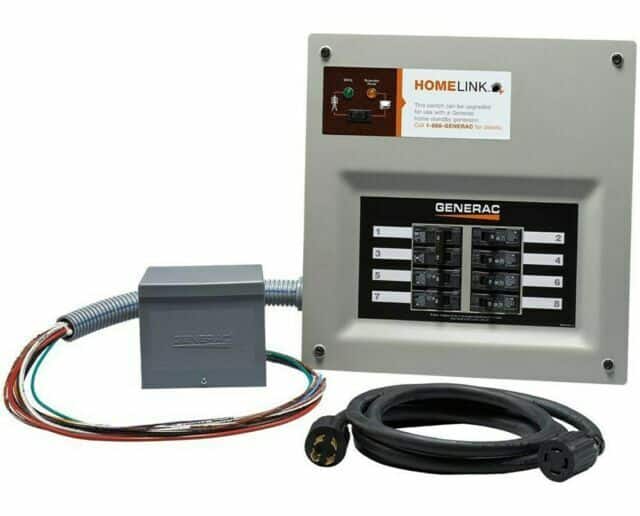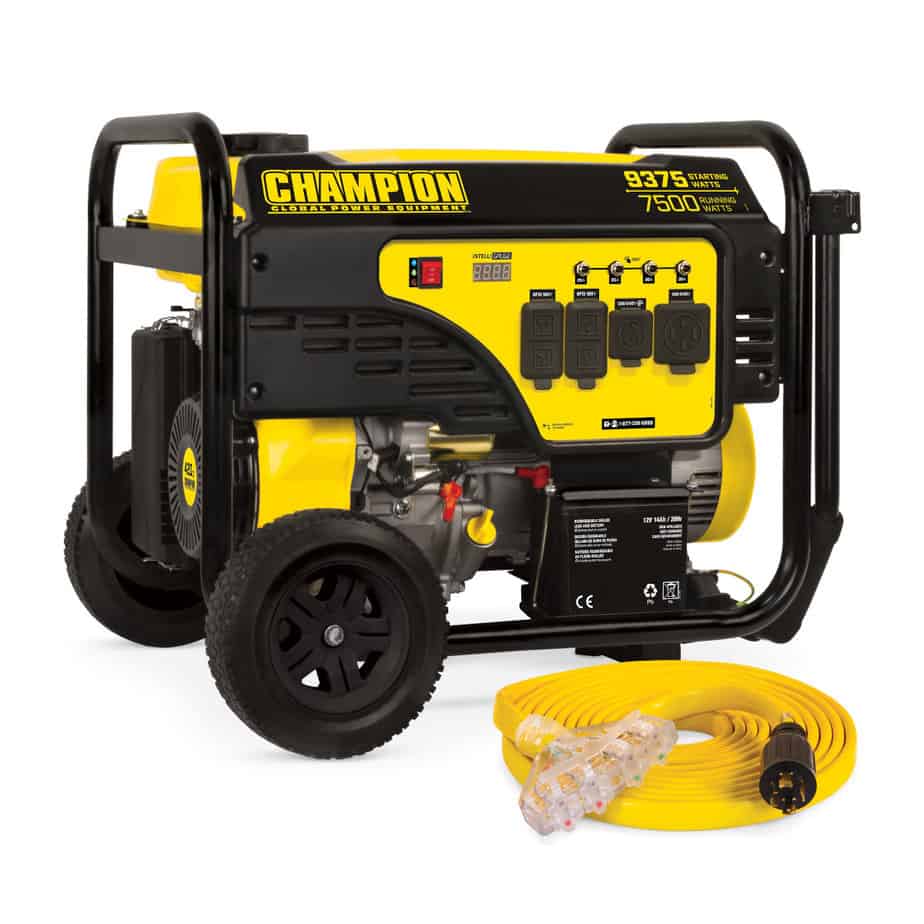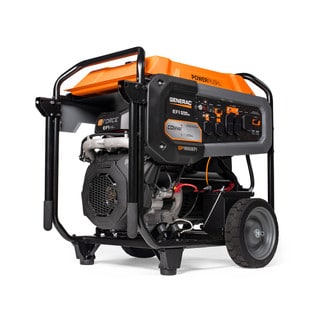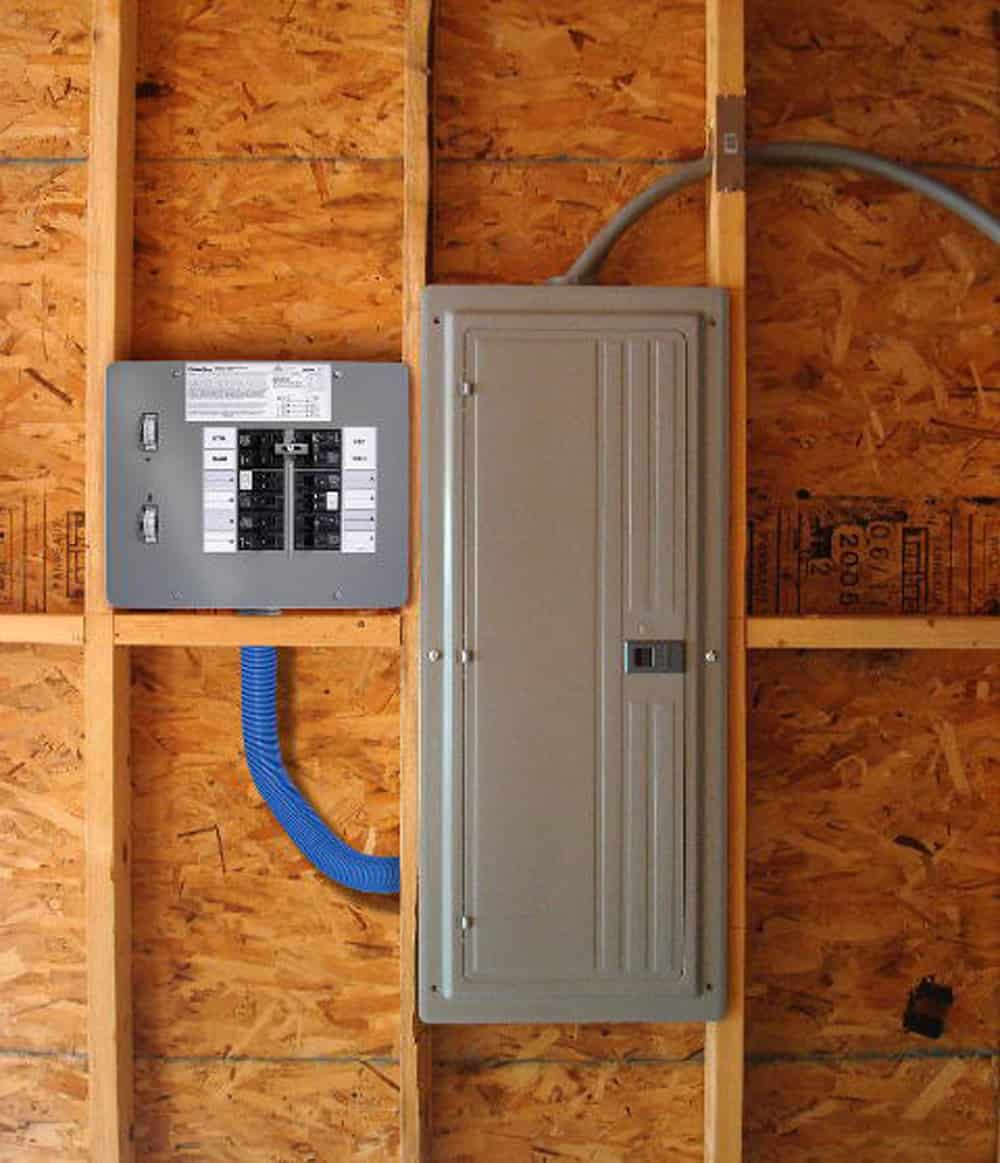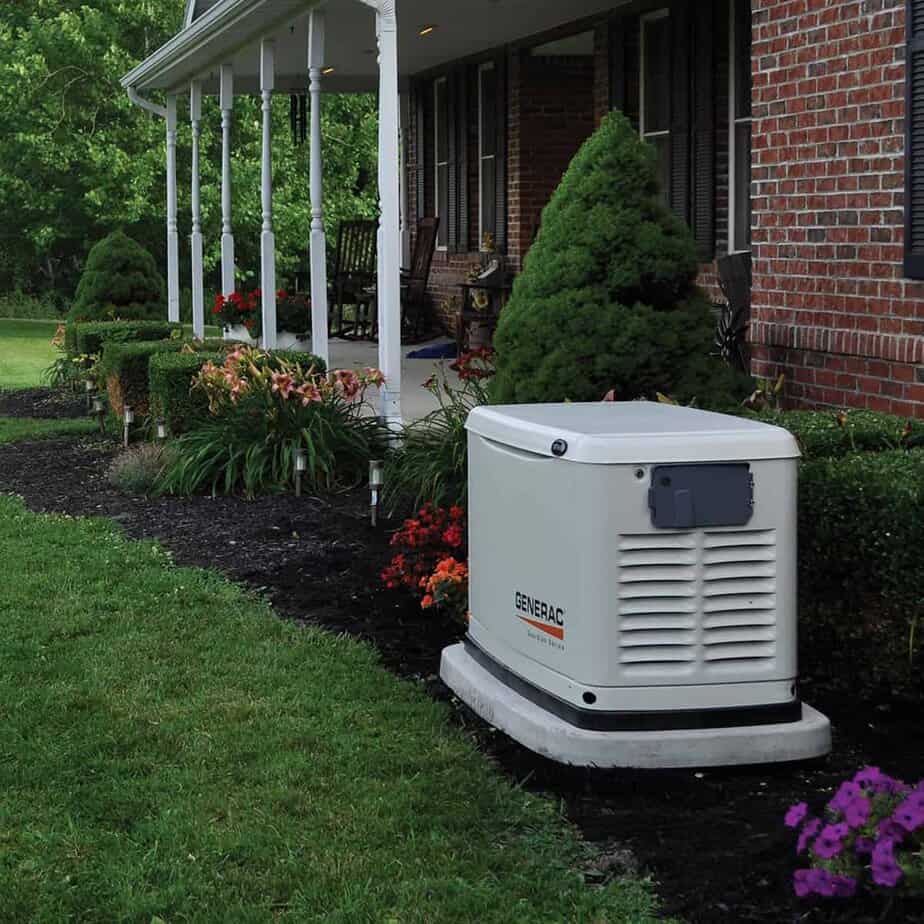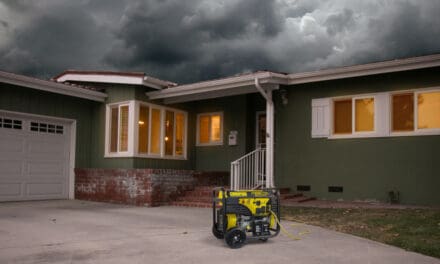Planning Materials for a Manual Transfer Switch Installation
Make a list of the materials you intend to use for your manual transfer switch installation. You will need the list to apply for the building permit, and having a list will limit returning to the store for more parts while performing the installation. Read Planning A Manual Transfer Switch Installation if you haven’t done so already.
Transfer Switch Options
The manual transfer switch that you select will depend on several factors. The primary consideration is the amount of power the portable generator can supply and the available power outlets on the generator. Typically, a portable generator that supplies a house will have a single 120/240-volt receptacle rated at 50-amperes or 30-amperes. Very large portable generators like the Generac GP17500E watt may have multiple 30-Amp and 50-Amp receptacles. If that is the case, you may need more than one manual transfer switch for the home to make full use of the generator’s power capability.
Portable Generator Manual Transfer Switch Basics
Some manual transfer switches only supply a single load. These control a sub-panel that distributes power to selected circuits by switching the sub-panel from utility power fed from the main service panel to portable generator power from the inlet box. Another single-load option is a critical appliance like a furnace or air conditioner.
Other transfer switches have the sub-panel built into them. The concept is the same. When the power goes out, the generator supplies power through the manual transfer switch to the circuits selected at installation.
Yet another possibility is a manual transfer switch at the service entrance that allows a portable generator to feed the main service panel. Generally, unless the homeowner is a certified electrician, local building departments may not permit the homeowner to install a whole house transfer switch without the help of a certified or licensed electrician.
Transfer Switch Importance in Portable and Standby Generator Systems
Many Portable Generators have a 30-Amp or 50-Amp 120/240-Volt Outlet, or both. These outlets require a 120/240-Volt Plug on a Generator Cord for connection to the inlet box. It’s a good idea to pair the largest outlet on the generator to the inlet box and transfer switch. For example, install a 50-Amp transfer switch and inlet box if your generator has a 50-Amp outlet and use a 50-Amp Generator Cord.
Manual Transfer Switches for Fast—Safe Home to Generator Connections
Transfer Switch Operation
The transfer switch controls the flow of power. During normal operation (utility power) the current flows from the main circuit breaker panel through a double-pole circuit breaker to wires connecting the breaker to the transfer switch. In normal operation, the transfer switch breaker in the main panel protects the switch and switch wiring from overload.
For generator operation (generator power) the owner moves the switch to the generator position which disconnects the transfer switch from the main panel and connects it to the generator. A circuit breaker on the generator protects the transfer switch and the wires to the inlet box, the inlet box receptacle, generator cord, and generator outlet
Circuit breakers in the transfer switch or a sub-panel receive power from the utility when the switch is in the utility position and from the generator when the switch is in the generator position.
Generac Homelink Manual Transfer Switch with inlet box, generator cord, and wiring for 8 circuit breakers. Available in 50-Amp and 30-Amp models.
Transfer Switch Circuit Breaker
The manual transfer switch installation guide will usually specify the current rating of the transfer switch circuit breaker installed in the main service panel—usually a double-pole, 240-volt breaker. This breaker protects the wiring between switch and the main panel from overloads. The current rating of this breaker is matched to the current-carrying capacity of the wires between the transfer switch and main panel.
Manual Transfer Switch Ready Portable Generators for Home Backup
Transfer Switch Wire Size
National Electrical Code (NEC) rules specify that wires that carry current must be protected by a circuit breaker matched to the current-carrying capacity of the wires (ampacity.) It is acceptable for the wire ampacity to exceed the breaker current rating, but the breaker current rating must never exceed the wire current-carrying capacity (ampacity).
The larger the wire gauge number, the smaller the wire and lower the current carrying capacity. 12-gauge wire is smaller than 10-gauge wire and larger than 14-gauge wire. Smaller gauge numbers equate to higher current capacity.
For example, 10-gauge copper wire may carry up to the 30 amperes and must be protected by a 30-ampere or smaller circuit breaker. A 12-gauge wire may only carry 20 amperes. You can use 10-gauge wire with a 20-ampere breaker, but never use 12-gauge wire with a 30-ampere breaker.
Installation Wire Sizes
The transfer switch installation includes wiring for:
- Inlet box to transfer switch.
- Circuit breaker panel to transfer switch.
- Transfer switch circuit breakers.
Wire Sizes Matter
Wiring for all three facets of manual transfer switch installation require the correct wire size. It’s okay, in some cases, to use a larger wire than necessary; For example, 12-gauge instead of 14-gauge. 12 gauge is a larger wire than 14.
It is dangerous to use a smaller wire size than required; Never use 14 gauge instead of 12, for example.
Inlet Box to Transfer Switch Wire Gauges
A circuit breaker on the generator protects the outlet, generator cord, inlet box, inlet box wiring, and the transfer switch from an overload. On most generators, the outlet is a 30-Amp or 50 Amp 120/240-Volt outlet and connects to a 30-amp or 50-amp 120/240-volt inlet box receptacle.
On the control panel below, the large double pole 50-Amp circuit breaker located second from the right controls 240-Volt 50-Amp outlet on the far left. The far left double pole 30-amp breaker controls the 120/240-Volt 30-Amp outlet that is second from left. The row of pushbutton breakers protect the 30-amp 120-volt outlet, and the two 120-volt 20-amp GFCI household duplex outlets.
If the current through any outlet exceeds the outlet’s circuit breaker maximum for more than two or three seconds, the breaker trips. A short circuit causes it to trip instantly. This protects the outlet, the generator cord from the outlet to the inlet box, the inlex receptacle, and the wiring from the inlet receptacle to the transfer switch.
The wiring from a 30-amp inlet box to a transfer switch must be 10-gauge or larger. A 50-Amp inlet box requires 6-gauge or larger wiring.
Caution: Never connect a 50-amp outlet to a 30-amp inlet box because an overload of up to 20 amps is possible without tripping the circuit breaker. This could cause a fire or damage the transfer switch, inlet box, and wiring.
Main Circuit Breaker Panel to Transfer Switch Wire Gauges
The circuit breaker in the main panel protects the transfer switch and the wiring from the main panel to the transfer switch. Install a double pole circuit breaker in the main circuit breaker panel that equals the transfer switch current rating. A 30-Amp transfer switch requries a 30-amp double pole breaker in the main panel.
| Transfer Switch Rating Amps | Largest Circuit Breaker Amps | Wire Gauge* |
| 15-Amps | 15-Amps | 14 AWG |
| 20-Amps | 20-Amps | 12 AWG |
| 30-Amps | 30-Amps | 10 AWG |
| 50-Amps | 50-Amps | 6 AWG |
| 60-Amps | 60-Amps | 6 AWG |
| 100-Amps | 100-Amps | 2 AWG |
*Wire Gauges Provided for 75° C Rated Wire. For other ratings, see NEC table 316.16.
Generator Wire Size by Circuit Breaker
- 15-amp breaker: 14-gauge wire
- 20-amp breaker: 12-gauge wire
- 30-amp breaker: 10-gauge wire
- 50-amp breaker: 6-gauge wire
- 60-amp breaker: 6-gauge wire
Note: Most inlet boxes have a 30-Amp or 50-Amp Receptacle. The wires from the inlet box to the transfer switch much meet or exceed the minimum wire size for a 30-Amp or 50-Amp breaker depending on the receptacle rating. If the inlet is rated at 50-Amps, you must use wire rated for 50-amps. For example, even if your generator supplies less than 30 amperes, safety and NEC codes still require the use of 10-gauge wire or larger wire for a 30-amp inlet box.
Note: A 50-amp outlet on a generator will have a 50-amp breaker. All wiring between the generator 50-amp outlet and the transfer switch must be rated for 50 amps and no less, even if the load connected to the transfer switch is less than 50 amps.
Note: Branch circuit wires follow the same rules. The smallest size branch wire allowed is 14 gauge wire with a maximum circuit breaker size of 15 amps.
Wire Size for a 240-Volt Circuit
In the USA and North America, a 240-Volt Circuit uses two 120-Volt supplies to make 240 volts. Each supply wire may carry the maximum rated capacity of the circuit breaker.
The 240-volt circuit supply is a double-pole circuit breaker. A 30-Amp double-pole circuit breaker has two breakers, each rated at 30-amps, tied together so if one trips, they both trip. The wire size for a 30 Amp 240 volt circuit is 10-gauge or larger because each wire and each circuit breaker may carry up to 30 amps. 50 Amp 240 Volt Wire Size is 6-gauge or larger. Other wire sizes follow the same rules.
Conduit
PVC Conduit is easy to install and suitable for use in most single-family homes less than three stories high.
Electrical codes limit the number of wires inside a conduit, depending on the wire gauge and conduit diameter. The wires may only use up to 30 percent of the space inside the conduit. For example: The wires between the transfer switch and main distribution panel may include four 6-gauge wires, four 12-gauge wires, and four 15-gauge wires. The minimum PVC conduit size will be 1 1/4 inches.
To run four, 10 gauge wires from the inlet box to the transfer switch requires 3/4-inch conduit, but four 6-gauge wires requires a minimum of 1-inch conduit.
Each installation is different. Consult the NEC conduit fill charts in a wiring guide to help you choose the correct size conduit.
*To avoid wiring errors, consult a licensed electrician before beginning any work.
Updated October 14, 2022



